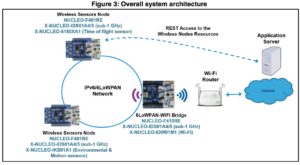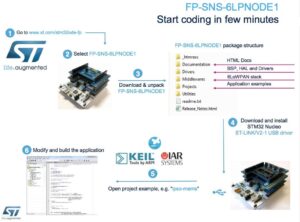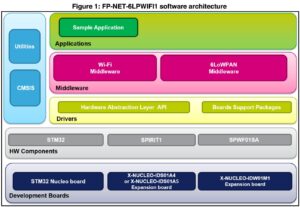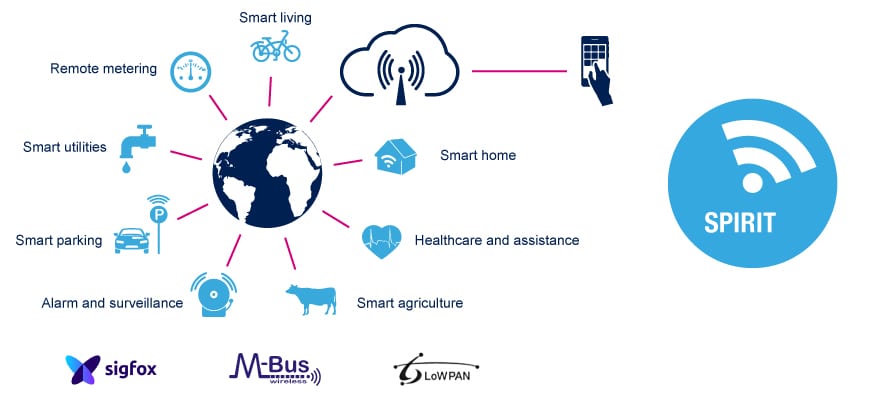ST offers Function Packs to jump-start a 6LoWPAN project, and today, we’ll focus our attention on two of them, the FP-NET–6LPWIFI1 and FP-SNS–6LPNODE1. They include source codes, and applications, to make prototyping easy and shorten development times. As startups, multinational corporations, or governments, take advantage of the Internet of Things, they need complete and modern solutions that provide answers to the multitude of issues they face. Many use ST’s RF transceivers, like Wi6Labs, to design solutions that better connect devices over long distances. Yet, choosing the right set of components is only a small piece of the puzzle.
| To experiment with the Function Packs:
|
Choosing 6LoWPAN

Selecting the right network for your application is challenging. 6LoWPAN (IPv6 Low-Power Wireless Personal Area Networks) is great for consumer and industrial products that connect small devices to a cloud or server on the Internet. The standard is very attractive because of its openness and reliance on well-known technologies. Although it was first designed to use the 2.4 GHz band, it has since been modified to take advantage of Power Line systems, and low-power sub-gigahertz transceivers, therefore adapting the technology to cover even more use cases.
The main advantage of 6LoWPAN is its ability to connect low-powered devices to the cloud. Despite their small processing capability, they can be part of a mesh network that sends and receives information, and because the technology relies on basic IPv6, simple routers, and straightforward nodes, it is possible to design very affordable solutions, reducing the barrier of entry. 6LoWPAN structures also scale fairly easily, meaning that it doesn’t take much to convert a project designed for a limited setup with few nodes, like a home, and port it to an industrial environment with far more nodes, for instance.
FP-NET–6LPWIFI1 and FP-SNS–6LPNODE1 at Your Service

6LoWPAN modules can use a sub-gigahertz transceiver, like the SPSGRF–868 and SPSGRF–915, that are based on the SPIRIT1 RF transceiver, or the expansion boards that integrate them, such as the X-NUCLEO-IDS01A4, and X-NUCLEO-IDS01A5. However, building a 6LoWPAN application from scratch can seem like a daunting task. It is not enough to have great hardware, one must also have software solutions to take advantage of it.
This is why ST offers these FP-NET–6LPWIFI1 and FP-SNS–6LPNODE1. They provide the quantum leap a prototype needs to get off the ground. The former will help create a bridge that connects a 6LoWPAN network to the Internet, while the latter will setup a node that records values using a sensor board, and will send them to a cloud server. They both include documentation, drivers, open-source codes, application examples, and libraries. They even contain special folders that greatly facilitate the import process into popular toolchains like Keil, IAR, or System Workbench for STM32.
Building Blocks
To better understand the wealth and treasures found in these two packs, we sat down with two members of the ST Central Labs (CLABS): Marco Grella, Software Project Leader, and Fabien Castanier, Software Design Manager. Together, they explained that at their core, the two Function Packs are solutions that will recommend hardware combinations, and provide software to implement general and popular 6LoWPAN use cases. Taken as is, FP-NET–6LPWIFI1 and FP-SNS–6LPNODE1 become building blocks that get customers started on their network in record times.
There are even pre-compiled binaries that make setting up a node, or a 6LoWPAN Wi-Fi Bridge, as simple as dragging and dropping an application onto the volume of a Nucleo board, like the Nucleo-F401RE, which is great if one is trying to get a feel of the application. However, one of the most underrated features is that the software package is preconfigured to provide a turnkey solution for different hardware configurations using a LwM2M client. As a result, these Function Packs can quickly turn into the foundations of your applications.
Opened and Optimized

The reason these Function Packs make life so much easier, is because they take all the recent standardization efforts from different projects, and all the complexity of using an Internet paradigm, and they port them to resource-constrained modules. As a result, users don’t have to worry about implementing these technologies. They can simply start focusing on how they’ll use that technology in their application.
This approach also explains why the applications in the Function Packs use Contiki OS. By relying on this open-source operating system, ST ensures that users have access to a well-established community that will greatly help overcome the challenges engineers could face while building their application. On top of it, ST has also optimized some libraries. For instance, there are changes to the ip64 code to take into account the fact that nodes are often asleep for a long time, and therefore don’t require constant open connections. As a result, just by using the Function Packs, engineers and enthusiasts get access to massive hardware and software optimizations that will make developing applications that much easier.
Lowering the Barrier of Entry
The FP-NET–6LPWIFI1’s and FP-SNS–6LPNODE1’s best hidden feature is their ability to start a project at a fraction of the price of a typical 6LoWPAN prototype. Both are completely free, and their codes are under an open-source license, to save time, and ensure that products can quickly and easily comply with the different standards.
ST even provides a free development environment, the System Workbench for STM32 (SW4STM32), and a community dedicated to answering questions about STM32 MCU’s and related projects. Hence, the only real cost of entry is US$100, approximately, to buy the components recommended by the Function Packs, and the time one is willing to invest, knowing that the software ensure the creation of an operational network in minutes.
The Extra Mile
Once a 6LoWPAN network is running, the next step is familiarizing oneself with the underlying technologies and standards. Among others, it includes LightweightM2M, and CoAP, which transforms a very simple sensor node into a web server, using the REST model. It is possible to start using the Function Packs, and ST’s boards, even if you have no knowledge of what goes on behind the scenes. The FP-NET–6LPWIFI1 and FP-SNS–6LPNODE1 make it very easy to create a 6LoWPAN network and experiment with it. They require only very basic prior knowledge to get running.
As a result, when you do start to get deeper into the technologies that make a 6LoWPAN network so great, you’ll have a practical tool to help you learn and master these protocols. Finally, ST published an article on the IPSO Alliance’s website that will provide more context from a standardization point of view.
The FP-NET–6LPWIFI1 and FP-SNS–6LPNODE1 are active and ongoing projects that continue to benefit from the work of Marco, Fabien, and many more at ST. In fact, new features revolving around the cloud connectivity of the Wi-Fi bridge will be available soon. Hence, we look forward to the improvements and advancements that these two Function Packs will continue to bring as they make 6LoWPAN more accessible, and affordable.
